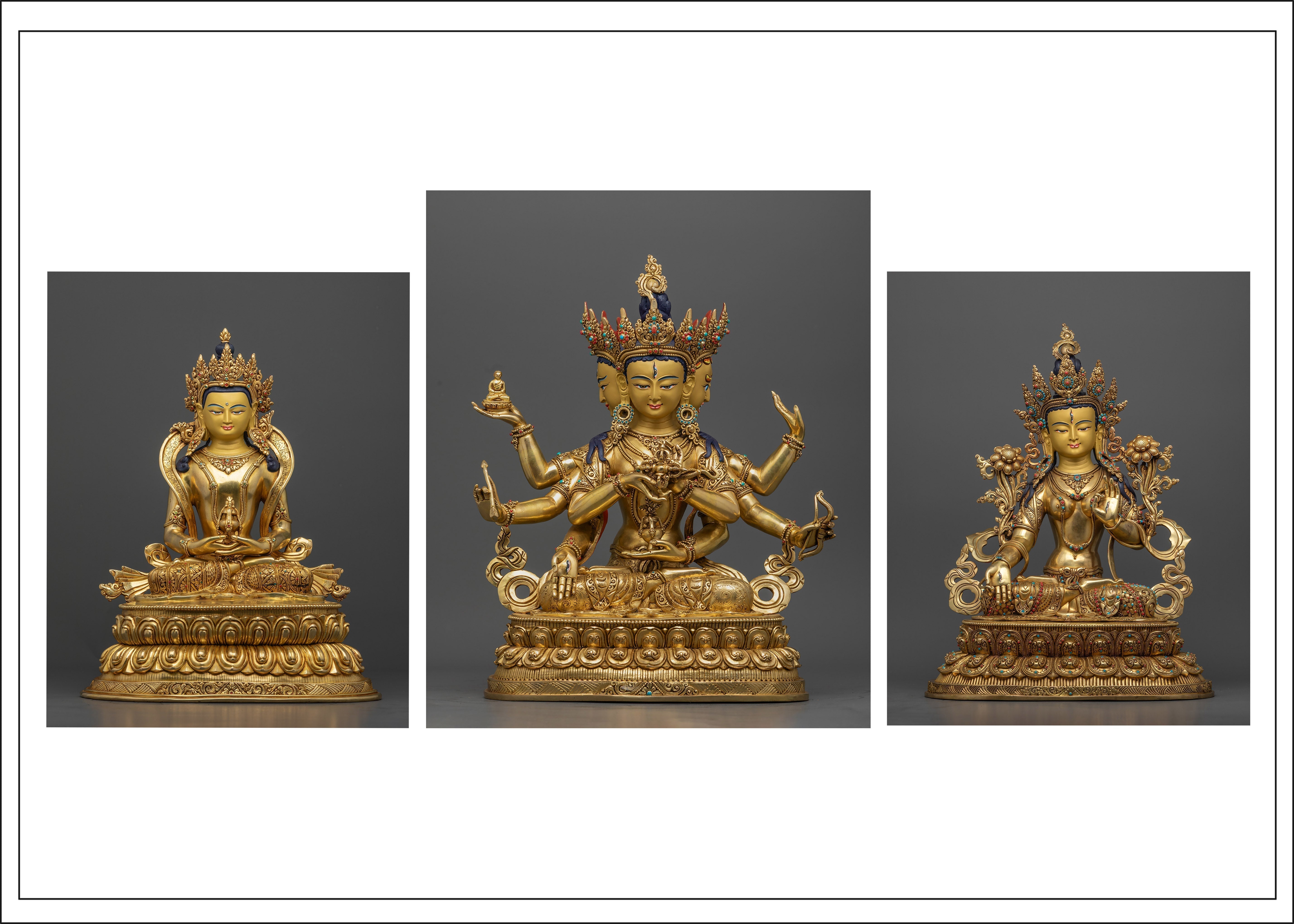The Three Long Life Deities in Tibetan Buddhism: Amitayus, Namgyalma & White Tara
Longevity in Tibetan Buddhism
In Tibetan Buddhism, long life is not just about living for many years. It's about sustaining a life filled with wisdom, compassion, and spiritual growth. To support this aspiration, practitioners often turn to the Three Long Life Deities: Amitayus, Namgyalma, and White Tara. These enlightened beings are revered for their power to purify obstacles to long life, heal illness, and promote vitality and spiritual accomplishment.
In this article, we explore who these deities are, what they represent, and how devotees connect with them in daily practice.
Who Are the Three Long Life Deities?
The Three Bodhisattva Deities of Longevity: Amitayus, Namgyalma, and White Tara, who are often invoked together during longevity rituals, meditation, and empowerment ceremonies. They are considered manifestations of different aspects of enlightened compassion and wisdom.
Let’s dive into each of them:
1. Amitayus: The Buddha of Infinite Life
Amitayus (Tibetan: Tsepakme) is the Buddha of Infinite Life and a sambhogakaya (enjoyment body) form of Amitabha Buddha. He is closely associated with longevity, merit, and wisdom.
Iconography:
Amitayus is often depicted sitting in meditation posture, wearing royal ornaments, and holding a long-life vase (ambrosia-filled vessel) in his lap. His expression is calm, radiant, and compassionate.
Symbolism:
-
Vase of Amrita (nectar): Represents the essence of life and spiritual vitality.
-
Red body color: Symbolizes boundless compassion and the fire of wisdom.
Browse our collection of hand-crafted Amitayus statues — consecrated upon request.
How to Connect:
-
Recite the Amitayus mantra: Om Amarani Jiwantiye Soha
-
Visualize Amitayus above your crown, pouring nectar into your body to cleanse disease and extend life.
-
Use his image or statue during long life rituals.
2. Namgyalma: The Goddess of Immortality
Namgyalma (Tibetan: Tsepagme) is a female deity known for her ability to purify negative karma, protect from untimely death, and grant long life. Her practice is also considered powerful for the deceased and for those in dangerous circumstances.
Iconography:
Namgyalma is usually depicted with three faces and eight arms, signifying her all-seeing wisdom and manifold compassionate activity. One face is peaceful, one is semi-wrathful, and one is wrathful—reflecting her ability to pacify, enrich, and subdue.
Symbolism:
-
Three faces: Represent the past, present, and future.
-
Eight arms: Show her multifaceted power to liberate beings from suffering.
-
White color: Symbolizes purity and healing.
How to Connect:
-
Recite the Namgyalma mantra: Om Bhrum Soha Om Amrita Ayur Da Dai Soha
-
Practice her sadhana or use her image in healing rituals.
-
Hang Namgyalma mantra banners or prayer flags for protection.
3. White Tara: The Mother of Compassion and Long Life
White Tara (Tibetan: Drolkar) is one of the most beloved female bodhisattvas in Tibetan Buddhism. She embodies the nurturing and healing aspects of Tara, offering blessings of longevity, compassion, and protection.
Iconography:
White Tara is depicted seated in a meditative pose, with seven eyes on her face, palms, and soles, symbolizing her watchful compassion over all sentient beings. She holds a blooming lotus and displays the gesture of granting boons.
Symbolism:
-
Seven eyes: Her omnipresent awareness and responsiveness.
-
Lotus flower: Purity and divine feminine energy.
-
White color: Wisdom, peace, and long life.
How to Connect:
-
Recite the White Tara mantra: Om Tare Tuttare Ture Mama Ayur Punya Jñana Pustim Kuru Soha
-
Visualize White Tara sending light and healing energy to your body.
-
Offer white flowers, milk, or light to her statue or thangka.
👉 Learn More About White Tara's Seven Eyes
Why Practitioners Invoke All Three Deities Together
Although each deity has its unique attributes, together they form a powerful triad in Tibetan longevity practices. Invoking all three is believed to bring:
-
Purification of negative karma and obstacles
-
Restoration of life force (Tibetan: “tsé”)
-
Increase in wisdom, spiritual strength, and compassion
-
Protection from accidents, illness, and untimely death
This triad is especially important in long-life empowerment ceremonies and tsé-drup (longevity accomplishment) retreats held in Tibetan monasteries.
How to Incorporate the Long Life Deities in Your Practice
Even if you’re not initiated, you can still build a meaningful connection with these deities through simple yet sincere practice:
-
Create a Long Life Altar: Place images or statues of Amitayus, Namgyalma, and White Tara with offerings like flowers, candles, and incense.
-
Chant Their Mantras: Mantra recitation with devotion is believed to invoke their blessings instantly.
-
Offer Light or Nectar Water: These symbolize clarity, vitality, and purification.
-
Daily Visualization Practice: Imagine the deities above your crown radiating healing nectar and light.
These practices, when done with intention and consistency, can promote not just physical longevity but also mental clarity, spiritual resilience, and emotional well-being.
Final Thoughts
In Tibetan Buddhism, long life is not just a personal blessing; it's an opportunity to deepen your practice and benefit others. The Three Long Life Deities: Amitayus, Namgyalma, and White Tara serve as compassionate protectors and guides on this path.
Whether you are a seasoned practitioner or someone beginning your journey, connecting with these deities can be a source of healing, peace, and spiritual vitality.































Share:
Top 5 Vajrayana Buddhist Deities and Their Meanings
Green Tara : History, Meaning and Spiritual Significance